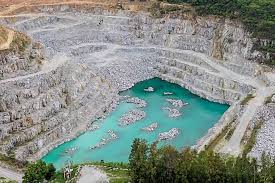Is your coal mine struggling with wastewater issues? Mine water contains coal dust, suspended solids, and dissolved minerals. If not treated properly, it can lead to environmental fines and wasted resources. How can you purify mine water efficiently? How can you reduce treatment costs? How can you reuse treated water?
At Shandong Hychron EnergyTech Co.,Ltd., we have specialized in water treatment nearly 20 years, serving China Coal Group, Mengtai Coal & Power Group, and Huaihe Energy Group. Our treatment solutions help clients reduce operating costs by 15% and remove 90% of pollutants, ensuring compliance with new environmental regulations while improving economic efficiency.
In this article, we will explain the characteristics of mine water, treatment methods, and the most effective chemicals used in coal mine wastewater treatment.

What Is Mine Water and Why Does It Need Treatment?
Mine water is the water that seeps into underground mining areas during coal extraction. It may also contain small amounts of surface water. The main characteristics of mine water include:
✔ Large volume: China’s annual mine water discharge exceeds 20 billion cubic meters.
✔ High suspended solids: Contains coal dust and inorganic salts, affecting water quality.
✔ Low organic pollution: Unlike industrial wastewater, mine water does not contain toxic substances.
Proper treatment and reuse of mine water can reduce pollution, save water resources, and bring significant economic benefits.
Mine Water Treatment Methods
1. Clean Mine Water – Direct Use After Disinfection
Applicable for: Mine water with minimal contamination. Treatment method: Directly transported through pipelines. If used for drinking water, it must be disinfected.

2. General Mine Water – Sedimentation to Remove Suspended Solids
Applicable for: Water containing coal dust and fine particles. Treatment methods:
✔ Underground sedimentation tanks: Water is treated inside the mine. Coagulants (PAC, PAM) are added to remove suspended solids.
✔ Surface sedimentation ponds: Water is transferred to ground-level ponds for natural settling before use in production or daily operations.
✔ Compact water purifiers: A system integrating coagulation, sedimentation, and filtration in one unit. Saves space and is cost-effective.

3. High-Salinity Mine Water – Advanced Desalination Methods
Applicable for: Water with high levels of dissolved salts. Treatment methods:
✔ Distillation: Removes salts through evaporation, but requires high energy.
✔ Electrodialysis (ED): Uses an electric field to separate salts, commonly used in China.
✔ Reverse osmosis (RO): Uses semi-permeable membranes to remove salts. Effective but costly.

4. Acidic Mine Water – pH Adjustment with Neutralization
Applicable for: Water with low pH levels, often due to geological factors. Treatment methods:
✔ Lime dosing: Lime milk is added to neutralize acidity and remove Fe²⁺.
✔ Limestone rotary drum: Limestone is placed in a rotating drum to increase reaction efficiency.
✔ Upflow limestone filtration: Water passes through limestone or dolomite media, increasing pH and removing Fe³⁺.
✔ Artificial wetlands (new technology): Plants such as cattails and rushes help remove Fe and balance pH.
5. Toxic or Radioactive Mine Water – Specialized Treatment Methods
Applicable for: Water containing fluoride, iron, manganese, heavy metals, or radioactive elements. Treatment methods:
✔ Activated alumina adsorption: Removes fluoride.
✔ Aeration and manganese sand filtration: Removes iron and manganese.
✔ Coagulation, sedimentation, and membrane filtration: Eliminates heavy metals and radioactive substances.
Automated Water Treatment Systems: High-Efficiency Mine Water Purification
Modern mines use fully automated water treatment systems to integrate coagulation, sedimentation, filtration, and disinfection into a single unit.
How the Automated Water Treatment System Works
🔹 Pipeline Mixing: PAC (Polyaluminum chloride) and PAM (Polyacrylamide) are added to the water. These chemicals help coal dust and other suspended solids clump together.


🔹 Sedimentation: The water enters a sedimentation tank. Suspended particles settle to the bottom and are discharged as sludge.
🔹 Filtration: The water moves into a filtration chamber. It passes through filter media to remove remaining impurities. Automatic backwashing ensures continuous operation.


🔹 Disinfection & Reuse: Treated water enters a disinfection tank, where chlorine dioxide is added to kill bacteria. The final water meets China’s GB50383-2016 coal mine water standard and can be used for dust suppression in the mine.
🔹 Sludge Treatment: The collected sludge is processed using filter presses to reduce waste volume. The dried sludge can be sold as solid waste material.
Standard Mine Water Treatment Process
Mine Water → Equalization Tank → Pump Station → Sedimentation Tank → Filtration → Disinfection → Reuse

Conclusion: Optimize Mine Water Treatment for Sustainable Coal Mining
Efficient mine water treatment is essential for environmental compliance, water recycling, and cost control. Every coal mine must adopt optimized water treatment technologies to meet modern regulations.
At Shandong Hychron EnergyTech Co.,Ltd., we provide customized solutions to help coal mines reduce treatment costs, improve water quality, and maximize water reuse.
🚀 Looking for an efficient mine water treatment solution? Contact us for expert consultation and customized solutions! 📩

